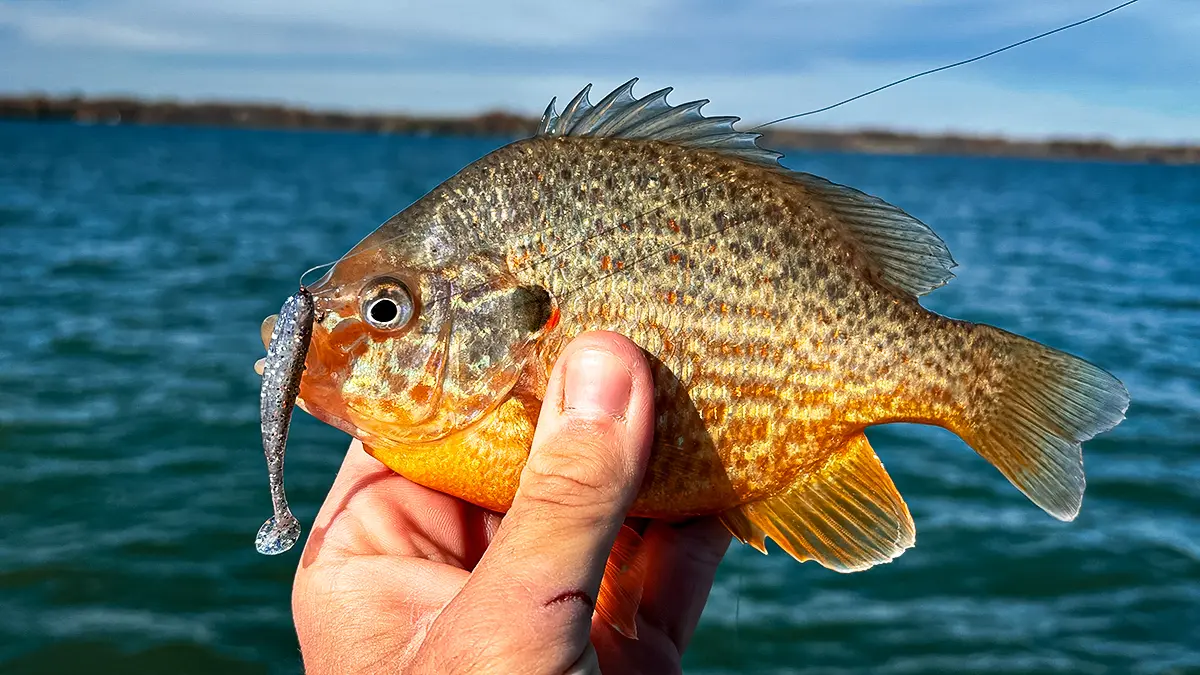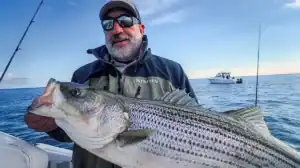With ice-out season finally upon us, it’s time to start thinking about getting some fresh fillets back in the deep freezer. Everyone like me, who isn’t big into ice fishing, have freezers that are pretty well empty of fresh fish right about now. There is no better way to refill that freezer than going out to some of the first lakes that open up and targeting some panfish. It’s a blast, a great way to get the whole family out there, and a great way to restock your fillets.
Personally, it also brings me back to my roots — where I started as a freshwater angler. I cut my teeth fishing small ponds, lakes, and drainages loaded with bluegills and crappies on Long Island. Now, everywhere I go, I’m constantly looking for little spots where I could potentially find some giant panfish. Nothing beats slabs on an ultralight rod as soon as the ice goes off the lakes; there’s truly nothing better!

Get In the Dirt and Take Cover
The biggest piece of advice I can give for both bluegills and crappies is to go as shallow as you can. These big slabs will be searching for the warmest water possible to both sun themselves and also feed. Like their bass cousins, crappies and bluegills will head shallow in search of warmer water as soon as the ice vanishes. These panfish have two things on their minds: feeding and getting ready to spawn. Once they get shallow, they usually won’t leave until the spawning period is over.
Once they get up on the banks, they’re usually looking to cling to a hard object that holds warmth — it could be a rock, a piece of wood, a dock — anything that retains heat. These fish are going to be slow and lethargic from the cold, and any spot that can help them get even a little bit warmer will be attractive.
Don’t Overlook Vegetation

Normally, when you think about vegetation, you think of the dog days of summer when it’s green and lush, but there’s plenty of vegetation during the ice out. Is there a lot of it? Not really. Is it alive? Not at all.
Fish are attracted to vegetation in the summer because it provides cover. Though the dead vegetation of winter and early spring doesn’t provide nearly as much concealment, panfish will still relate to them. Back when I used to ice fish, I noticed that the dead vegetation I would pull through the ice was littered with small scuds and macro invertebrates — when I put it on the ice, hundreds of scuds were visible. Ever since then, any sort of vegetation has been where I start to look for panfish in the spring. Bluegills are “peckers,” and feed heavily on these invertebrates all year long, but especially in the spring.
You Don’t Need a Boat to be Successful
Many anglers think they need some sort of boat to get out to where the best fishing is. That couldn’t be further from the truth. During the ice-out, fish seek the shallowest water, which is generally close to the bank: prime territory for the shore-bound angler.
Piers, docks and open shorelines are great places to start looking for panfish in the spring — start with parks and public fishing access spots. Check your local state conservation agency to find shore spots near you.

In the Finger Lakes region, the north and south ends of many of the lakes are public access with inlet and outlet creeks. And those creeks can be killer as they have all the key characteristics to hold big panfish in the spring.
Ice-Out Panfish Tackle and Tactics
When it comes to panfish, generally there’s three different setups I use with great success: a dropshot rig, a micro swimbait, and a slip float rig. They each have their time and place, but it’s all about utilizing the right one at the right time.
I mostly use dropshot rigs when fish are sitting just out of sight. Bluegills and crappies aren’t usually bottom oriented, but they do like to hang closer to the bottom.

My setup has a short leader of 10 inches or less between the hook and weight — just enough to keep the bait off the bottom but still be close to the bottom. I like light 6-pound-test line, or lighter — a smaller diameter fluorocarbon is fine. Yeah, they’re just panfish, but they can be very skittish.
I love Sunline FC Sniper in 5-pound-test. It’s not too heavy, and it’s not too light. For baits, I am a huge fan of the Reins Rockvibe Shaker and Reins Bubbling Shaker. They have incredible action and they’re soft but also durable enough to withstand the pecking power of a panfish.

Swimbaiting for panfish is a very underlooked technique. Most people think a bluegill would never eat a swimming bait like that, but it’s a great way to cover water and to locate a feeding school of either species. Bluegills, being as curious as they are, will always take a peck at the bait as it goes by.
There’s no better option than a 2-inch Keitech Easy Shiner or Keitech Swing Impact. I’ll usually have both of these tied on, because they have distinctly different actions. An Easy Shiner has a more aggressive tail kick, while the Swing Impact has a more subtle tail movement.

As to which one works better, that all depends on what the fish want more that specific day. Sometimes they like one better, sometimes they want both! Choose the size of your jighead based on how deep the fish are sitting. Anything in the 1/32- to 1/8-ounce range will work perfectly.
Onto the slip float rig: It’s not something I use often, but when fish are sitting suspended in the water column, you can’t beat it! I’m a huge fan of the Leland Lures family of baits. Whether it’s the Trout Magnet, Mini Magnet, or Crappie Magnet, Leland Lures has something in the panfish lineup for you. Their foam floats are made for their baits which are perfect when slip float fishing for panfish. A slip float rig is pretty self explanatory, it’s the way our parents and grandparents taught us to fish. Waiting for that float to go under is always the hardest part!

For a rod, reel, and line combo, I have the same setup across the board. A 6’6” light-action G Loomis GCX Lite series rod paired with a 1000 size Shimano Sedona reel spooled with five pound Cortland Masterbraid. This is the ideal panfish setup. The rod has a great backbone with a super-sensitive tip that will let you feel even the lightest little panfish bites. The braid is the biggest player; it allows for longer casting distance with the thin diameter and allows you to feel bites better. You can’t beat a super light setup like this one.
—

Overall, panfishing is a great way to get the pre-season jitters out of the way in the early spring. Getting that first bite of the year drags you back into the swing of things while you fill the freezer a bit. Plus, it’s the perfect excuse to take your kids out for a few hours for some quality time catching a few fish for dinner. It’s a win-win-win.












